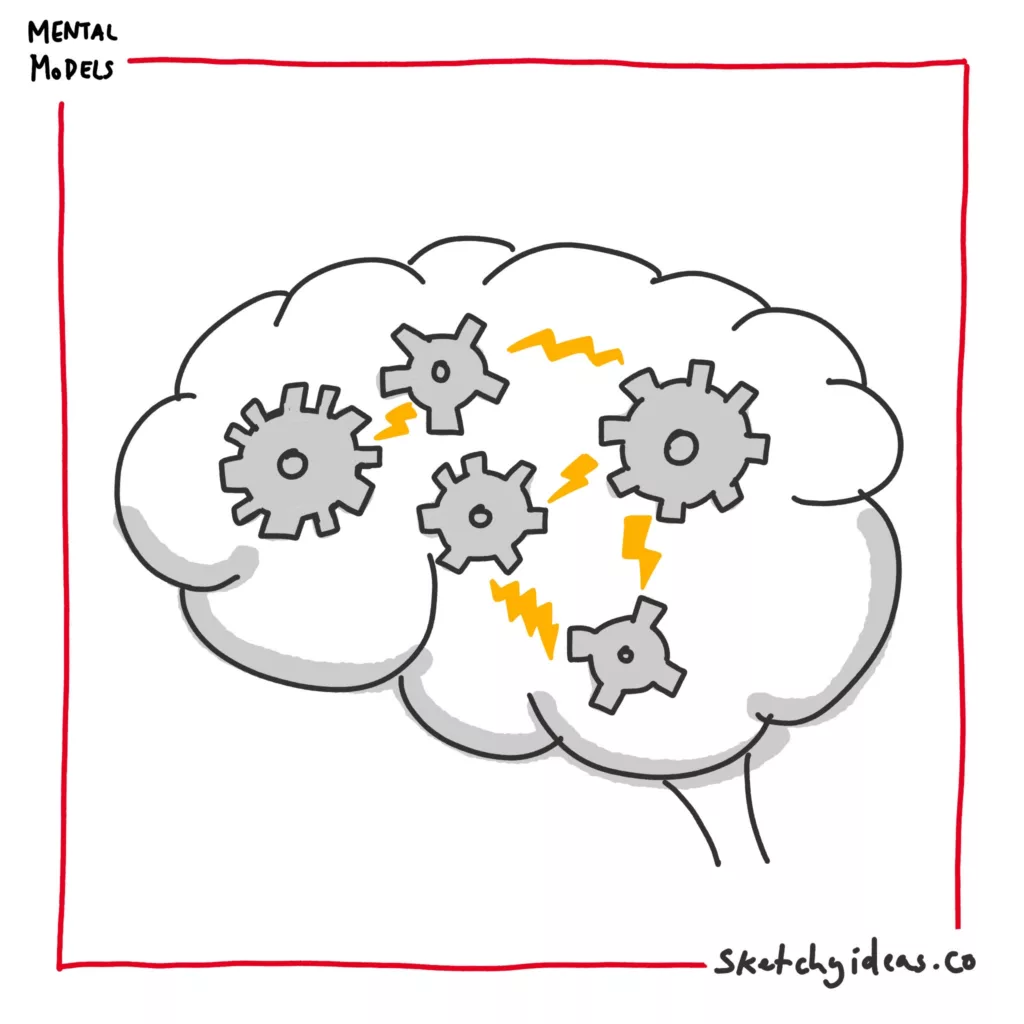The human brain takes in 11 million bits of information a second. But it can only process 40 to 50 bits a second. This applies beyond just our immediate senses, when we make decisions we don’t consider all the data. Instead, we use frameworks, systems and filters to help guide our decisions, and that’s where mental models come in.
In this article, I’ll take you through what they are, the benefits they bring and provide some example models that can help you reap the benefits of this approach to thinking.

What are mental models?
A mental model is a representation (model) of how things work in the world. We each have mental models from our experiences and we use these to understand information, make predictions and decide on what we should do.
They may arise from observations in one area but can be applied to other fields.
By gaining new mental maps we can improve our decisions, predictions and understand of the world. In fact, some discoveries were only possible once people gained new ways of looking at the world.
Streamline making decisions
Making good decisions is hard and takes time.
Mental models can help us navigate new situations using thought patterns that have worked in the past. They can help us work out what actually matters even when we’re ignorant of the topic.
This means better decisions, faster even in new experiences.
Be a more critical thinker
We all fall into cognitive biases and logical fallacies now and then.
In fact, some are bad mental models we’ve picked up over time. By focusing on refining, replacing and adding new models, we can remove our blind spots and become more critical thinkers.
Improve your problem-solving skills
Mental models give you a tool kit to solve problems.
By gathering a set of ways to focus on the information that matters, understand what the data in front of you is saying and act in light of that data, you can solve problems more effectively. By using models from outside of your field, you can come up with unique solutions.
Learn and apply new ideas & skills faster
Mental models help us understand and breakdown new ideas and skills.
This is a critical step in learning a new topic or idea. By identifying the patterns and principles of an idea or skill, you can learn not just the theory but how it works in practice too.
Improve your communication and empathy
We don’t all see the world in the same way.
We have different experiences, background and thought processes that change our perspectives and actions. By understanding different models, we can better understand others’ viewpoints. This enables us to communicate more effectively.
Mental models let us live in someone else’s world.
Compounding benefits
Mental models compound over time.
The more models we acquire and learn when and how to apply them, the more they aid each other. We can even use models to figure out which model to use.
The sooner you start building your toolbox, the greater the benefits you’ll reap.
Mental models to explore
If you want some practical examples, explore this growing list that I’m curating. Each one has a hand drawn illustration to help you understand and remember the concept better.
-
The Circle of Competence: A Mental Model to Avoid Mistakes
-
How inversion can help you solve problems where you have no idea how to start
-
The Power of Second Order Thinking: Making Better Decisions for a Better Life
-
Occam’s Razor: The Atomic Mental Model
-
Probabilistic Thinking: How to Make Better Decisions in an Uncertain World
-
Hanlon’s Razor: reduce stress and build better relationships
-
The Power of the 5 Whys Technique: A Journey to Root Cause Analysis
-
Reversible vs. Irreversible Decisions: The Key to Avoiding Overthinking
-
Bike Shedding: Tackling the Trivial and Embracing Priorities
-
Inertia: a mental model to achieve real change
-
The Tipping Point: a mental model to help ideas spread
-
First-principles thinking: The Key to Unlocking Creative and Innovative Solutions
-
Hofstadter’s Law: Why Projects Are Always Delayed
-
The Power of Compounding: Unlocking Exponential Growth and Long-Term ‘Success
-
The Diderot Effect: Avoiding the Spiral of Consumerism
-
The Power of Divergent and Convergent Thinking
-
Multiplying by Zero: A Mental Model to Avoid Disaster
-
The Principle of Least Effort
-
Leverage: a mental model for maximum results
-
The 80/20 Rule: Getting more from less with the Pareto Principle
-
Falsifiability: A mental model to search for truth
-
The Rule of 7: Unveiling the Power of Repetition in Consumer Choices
-
The Lindy Effect: A Tool to Predict Longevity and Value
-
Antifragility: Thriving in Chaos and Uncertainty
-
The Benjamin Franklin Effect: Favour-Induced Affection
-
Lead and Lag Measures: Two Metrics To Achieve Your Goals
-
Want better meetings? Try the Two Pizza Rule
-
The Hawthorne Effect: Boost Your Productivity Through Awareness
-
10 visuals to help you make better decisions this coming week
-
10 visuals to help you learn more this coming week
Start building your collection of mental maps
By being more intentional about how we think and the filters and maps we use to look at the world, we can improve our thinking and decisions. Subscribe if you want new models in your inbox.

Leave a Reply